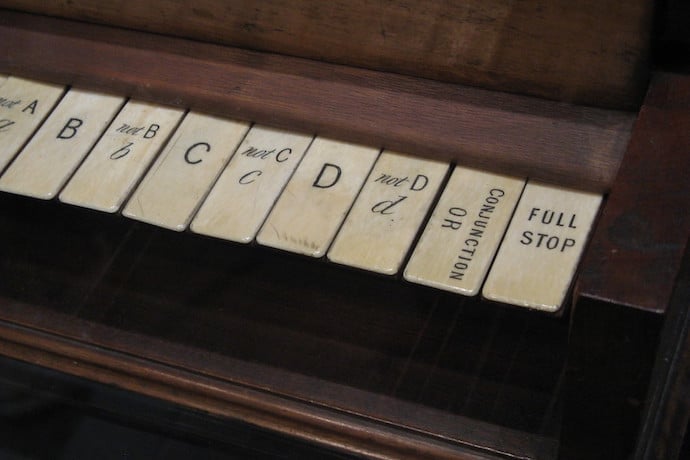Computers today are amazing devices whether they are a smartphone or a VR headset or a laptop or a guidance system in an airplane. Computers, however, are really basic technology: they solve human problems that take far more time than we have available. An airplane guidance system, for example, collects location, airspeed, and other data in real time then performs calculations used to guide the plane from takeoff to landing.
The only big difference between computers today and computers from the past are the tools and ideas available to create them.
Humans first counted, of course, with their fingers as well as objects like stones. This isn’t ideal. If you lost a finger taking down a mastodon, for example, you might have only four fingers (or three!) while your neighbors have five. Hands and objects also require human memory. Results are not stored semi-permanently or permanently.
The number system used to calculate also limited the ability of humans to create technology that can make calculations. Roman numerals, for example, are difficult to use in calculations. Arabic numerals, used in India then carried to the Mediterranean area by Arab traders, made it much easier to perform calculations. Thankfully, we still use Arabic numerals today.
These computers store data, at least temporarily, which makes it easier to use them to solve problems quickly and efficiently.
Abacus
First appearing over 5000 years ago in Babylon, today called Iraq, this device with beads that slide up or down a set of poles or wires set into a wood frame is considered the first computing device. It’s still in use today in some cultures. The position of a bead determines its value.
Napier’s Bones
A Scottish mathematician, John Napier (1550-1617, created logarithm tables to make calculations easier. His device, called Napier’s Bones, were widely used by accountants and bookkeepers. Napier’s device used ten rods, often made of white ivory which looked like bones. Logarithms are a math operation to determine how many times a number is multiplied by itself to reach another number. For example, 10 multiplied by itself two times (10×10) is 100. It’s a shorthand way to make calculations faster.
The Pascaline Calculator
In 1642, Blaise Pascal (1623 to 1662) created a geared calculator to help his father collect taxes. Instead of exhausting calculations and recalculations, the 19 year old Pascal built a mechanical calculator that could add and subtract. Cranking a handle moved a set of tooth gears to engage other gears and indicate amounts. A one-tooth gear, for example, revolved ten times to move the ten-tooth gear once.
Slide Rulers
Following on Napier’s Bones, a French artillery officer Amedee Mannheim (1831-1906) created a slide rule, a single long ruler set between two other long pieces. Calculations were made by sliding the long middle ruler then using cursors on the outside pieces. Logarithmic calculations could be made quickly without the need for the ten rods in Napier’s machine. Slide rules were in use until the 1970s or 1980s.
The Logic Piano
While not a calculator, this device built in 1869 by William Jevons demonstrated that logic problems could be computed with algebraic equations. It’s a series of boards with combinations of true and false terms arranged on a rack. A ruler was used to remove excluded combinations. While this device didn’t achieve it’s promise, today’s programming languages in electronic computers use the insights of Jevons and others to follow logic rules to make calculations.
Computors with an O
Starting in the 1700s and 1800s, the first modern computers were people and were called computors with an O. Mostly women who were very good at solving math problems, they did calculations used for ship navigation and later to fire cannons and other military equipment. For example, if a cannonball of a certain weight is fired at a set of specific angles, how far will the cannonball fly before it lands?
Computers with an E
ENIAC (Electronic Numerical Integrator and Computer)
ENIAC was the first US electronic computer that also could be programmed to perform tasks. It also was Turing-complete, a standard that measures whether or not a computer can recognize or decide other data manipulation rules and make changes. The ENIAC used about 18000 vacuum tubes which generated lots of heat and burned out frequently.
Altair 8800
Around 1971, Intel produced the first microprocessor which, in turn, was used in a $397 computer called the Altair 8800. You assembled the machine and programmed it by flipping switches in the front of the computer. Bill Gates and Paul Allen, two of the original founders of Microsoft, adapted the BASIC (Beginner’s All Purpose Symbolic Instruction Code) programming language to work with the Altair, making it even more useful. The Apple II, TRS-80, and other computers were created based on the success of Altair and BASIC.
Learn More
Eniac
https://www.britannica.com/technology/ENIAC
How to use an Abacus video
https://www.youtube.com/watch?v=SYRyKYmOJwM
Abacus
https://www.mathsisfun.com/numbers/abacus.html
Napier’s Bones
http://woollythoughts.com/napier.html
John Napier’s Bones
http://www.17centurymaths.com/contents/napier/jimsnewstuff/Napiers%20Bones/NapiersBones.html
Blaise Pascal
https://www.educalc.net/196488.page
How the Pascaline works – video
https://www.youtube.com/watch?v=3h71HAJWnVU
The Slide Rule
History of the Slide Rule
https://www.thoughtco.com/history-of-the-slide-rule-1992408
Logic Machines
https://www.encyclopedia.com/humanities/encyclopedias-almanacs-transcripts-and-maps/logic-machines
Human Computers: Women at Nasa
https://www.history.com/news/human-computers-women-at-nasa
Women in coding
https://www.nytimes.com/2019/02/13/magazine/women-coding-computer-programming.html
Altair 8800
https://americanhistory.si.edu/collections/search/object/nmah_334396

